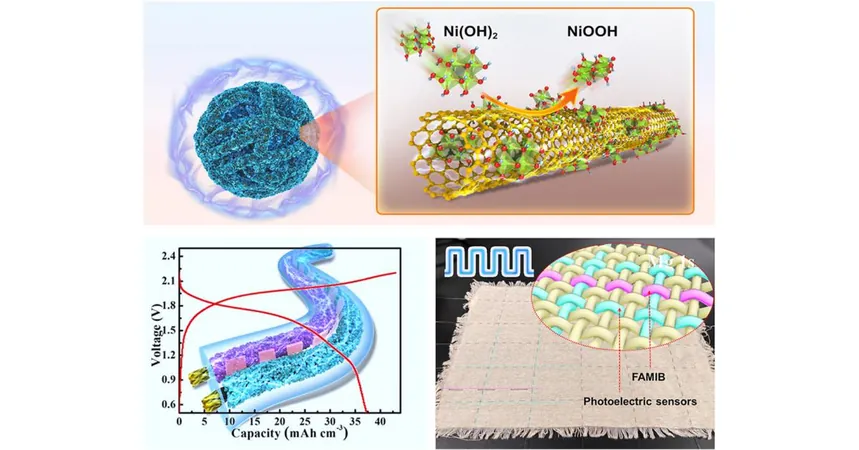
Revolutionizing Energy Storage: The Breakthrough of NiOOH in Aqueous Magnesium-Ion Batteries
2025-04-01
Author: Rajesh
Introduction
In a groundbreaking advancement for energy storage technology, researchers have successfully engineered a novel cathode material, nickel oxide hydroxide (NiOOH), which is set to enhance the performance of aqueous magnesium-ion batteries (AMIBs). This breakthrough not only addresses the longstanding issues of high voltage and energy density but also ensures a safer and more versatile solution for the battery needs of next-generation electronic devices.
The Promise of Aqueous Magnesium-Ion Batteries
As the demand for compact, efficient, and eco-friendly energy solutions skyrockets with the rise of wearables and portable electronics, aqueous magnesium-ion batteries emerge as a highly attractive alternative. With their innate safety features, high ionic conductivity, and non-toxic properties, they stand out compared to conventional batteries that use organic electrolytes. Nevertheless, obstacles like low energy density, slow ion diffusion, and material degradation have traditionally limited their application.
The Research and Development
A study from June 22, 2024, published in eScience, reveals the work of researchers from Nanyang Technological University and other esteemed institutions who synthesized layered NiOOH cathodes integrated with carbon nanotubes (NiOOH/CNT) for AMIBs. This innovative material employs a proton-assisted magnesium-ion intercalation mechanism, resulting in impressive discharge voltages, exceptional stability, and significant energy storage capabilities.
Dual Focus on Performance and Flexibility
This study emphasizes a dual focus on performance and flexibility. The NiOOH/CNT cathode boasts a specific capacity of 122.5 mAh/g, aided by a one-dimensional to two-dimensional heterostructure that promotes rapid electron transport and ensures robust cycling performance. Utilizing carbon nanotube fibers as flexible substrates, scientists have developed a freestanding NiOOH cathode. Coupled with a sodium titanium phosphate-based freestanding anode, they crafted a 'rocking-chair' battery system with an outstanding discharge voltage of approximately 1.7 V. This set-up is efficient, adaptable, and features fiber-shaped batteries that exhibit remarkable mechanical flexibility—ideal for wearables, including photoelectric sensors woven into fabrics.
Expert Insights
Lead researcher Professor Lei Wei expressed, 'This breakthrough redefines the potential of aqueous magnesium-ion batteries by combining safety, efficiency, and flexibility. It’s an exhilarating step forward in answering the energy needs of contemporary electronics while committing to sustainability and scalability.'
Far-Reaching Implications
The implications of this research are far-reaching. Beyond wearable technology, the enhanced safety and energy capacity of these AMIBs could revolutionize applications across medical devices, textiles, and even large-scale energy storage systems. By tackling critical limitations, this innovation positions aqueous magnesium-ion batteries as fundamental to the future of sustainable energy storage solutions.
Conclusion
As we move toward a more sustainable future, these developments underscore a major leap in battery technology that promises to meet modern energy demands while easing environmental impacts. The next generation of energy storage is not just around the corner—it's being redefined now.




 Brasil (PT)
Brasil (PT)
 Canada (EN)
Canada (EN)
 Chile (ES)
Chile (ES)
 Česko (CS)
Česko (CS)
 대한민국 (KO)
대한민국 (KO)
 España (ES)
España (ES)
 France (FR)
France (FR)
 Hong Kong (EN)
Hong Kong (EN)
 Italia (IT)
Italia (IT)
 日本 (JA)
日本 (JA)
 Magyarország (HU)
Magyarország (HU)
 Norge (NO)
Norge (NO)
 Polska (PL)
Polska (PL)
 Schweiz (DE)
Schweiz (DE)
 Singapore (EN)
Singapore (EN)
 Sverige (SV)
Sverige (SV)
 Suomi (FI)
Suomi (FI)
 Türkiye (TR)
Türkiye (TR)
 الإمارات العربية المتحدة (AR)
الإمارات العربية المتحدة (AR)